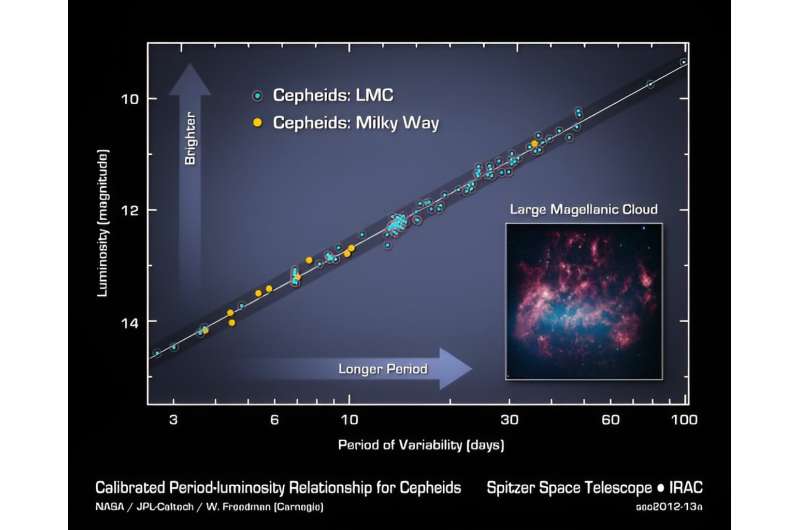Measuring the distance to far away objects in space can be tricky. We don’t even know the precise distance to even our closest neighbors in the universe—the Small and Large Magellanic Clouds. But, we’re starting to get to the tools to measure it. One type of tool is a Cepheid Variable—a type of star that varies its luminosity in a well-defined pattern. However, we don’t know much about their physical properties, making utilizing them as distance markers harder.
Finding their physical properties would be easier if there were any Cepheid binaries that we could study, but astronomers have only found one pair so far. Until a recent paper from researchers from Europe, the US, and Chile shows measurements of nine additional binary Cepheid systems—enough that we can start understanding the statistics of these useful distance markers. The paper is published on the arXiv preprint server.
Like traditional stars, binary Cepheid systems result when two stars orbit around each other. In this case, both of those stars must be Cepheids—meaning they are massive compared to our sun and much brighter. In addition, their luminosity must vary in a repeatable pattern so that we can track it consistently.
All of those features can vary a lot if two stars change in luminosity but at different rates and phases around each other. It’s difficult to parse out which star is waxing, which is waning, and which direction they are moving in, both compared to us and each other. Long periods of observation are required to fix some of those variables, and that is precisely what the new paper describes.
The researchers looked at nine sets of Cepheids that were believed to be binary systems but hadn’t yet been confirmed due to the difficulty of separating the two stars from each other. They pulled data from the Optical Gravitational Lensing Experiment (OGLE) database, a variable star observation project run by the university of Warsaw for over 30 years. In so doing, they could confirm, for the first time, that each of these suspected binaries contained two separate stars.

Those nine binary systems were located in the Small and Large Magellanic Cloud and the Milky Way. One located in the Milky Way is by far the closest, at only 11 kiloparsecs (about 3,000 light-years) away. The researchers also had good luck because of the length of orbital periods of the binaries they studied—most were over five years, and a shorter observational data set might not have caught them.
Understanding how these systems exist and where they are is just the first step. Using them for more helpful science is the next. The most obvious way to do so is to increase our understanding of Cepheids.
Despite being one of the most commonly used distance markers in the universe, we know surprisingly little about how they form, what they’re made of, or their life cycle. Closely studying a binary system, where the stars interact, could help shed light (figuratively in this sense) on some of those properties.
As the authors point out in their paper, this is part of a long-term ongoing project—they were also part of the team that confirmed the original Cepheid binary system back in 2014.
OGLE continues to collect more data, as are other sky surveys, and there are likely more Cepheid binaries out there. Every new discovery will help improve our statistical understanding of these critical distance markers—we just need to take the time to find them first.
More information:
Bogumił Pilecki et al, Cepheids with giant companions. II. Spectroscopic confirmation of nine new double-lined binary systems composed of two Cepheids, arXiv (2024). DOI: 10.48550/arxiv.2403.12390
Journal information:
arXiv
Provided by
Universe Today
Citation:
Astronomers only knew of a single binary Cepheid system—they just found nine more (2024, March 29)
retrieved 29 March 2024
from
This document is subject to copyright. Apart from any fair dealing for the purpose of private study or research, no
part may be reproduced without the written permission. The content is provided for information purposes only.